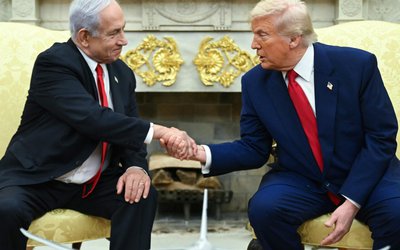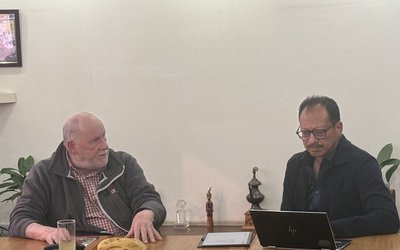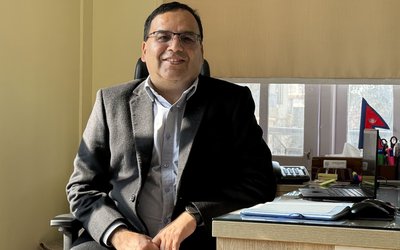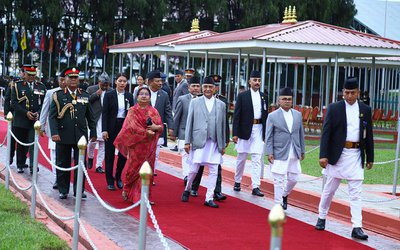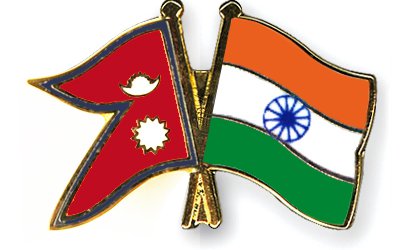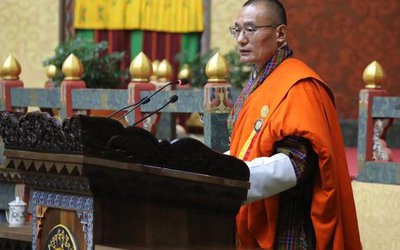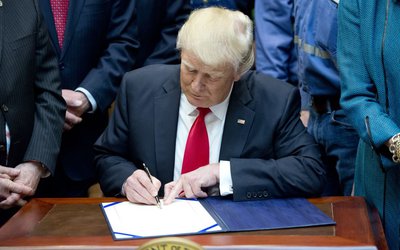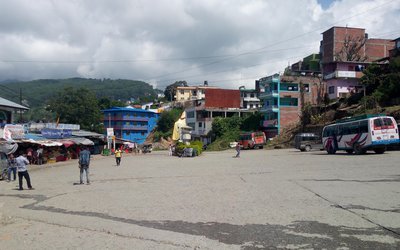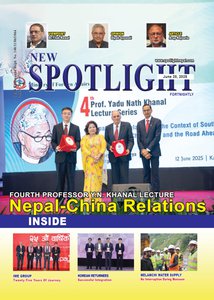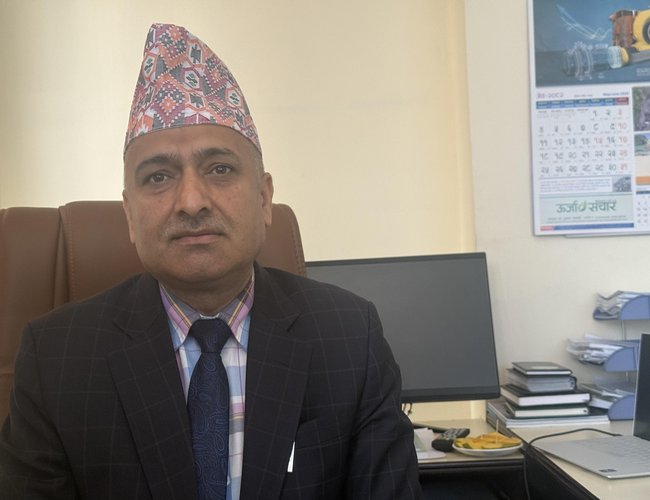
With extensive experience in the renewable energy sector, Dr. Ram Prasad Dhital, the Chairperson of the Electricity Tariff Fixation Commission (ETFC) in Nepal, is well-versed in the country's energy industry. Dr. Dhital, who was appointed as chairman nearly a year ago, is working to enhance the technical capabilities of the commission to address tariff and other related issues. Established as an autonomous body seven years ago to regulate electricity tariffs, the commission is now making significant progress under Dr. Dhital's leadership. In a conversation with Keshab Poudel, Dr. Dhital discussed various issues related to the commission's work
.Can you elaborate on the role and responsibilities of the Electricity Tariff Fixation Commission (ETFC)?
The Electricity Tariff Fixation Commission (ETFC) is tasked with determining and regulating electricity tariffs to ensure a fair balance between the interests of consumers and electricity providers, as well as promoting competition in the electricity market. Additionally, the ETFC oversees the technical management aspects of electricity generation, transmission, and distribution, and works to enhance the organizational capacity of licensed entities.
What is the significance of technical capability in the operations of the ETFC?
The Electricity Regulatory Commission Act 2017 and Electricity Regulatory Commission Rule 2018 grant the ETFC the authority to maintain a balance between electricity supply and demand, regulate various aspects of the electricity market, and ensure the reliability and quality of electricity services. However, the commission acknowledges that it has limited technical capacity to effectively oversee its broad mandate. Technical capability is crucial for the commission to fulfill its functions and strengthen its operations.
As the chairperson of the commission, how do you view the authority of the ETFC?
The ETFC is empowered by the Act to regulate electricity generation, distribution, transmission, and trade. The commission, consisting of five members including the chairperson, is operational and currently focused on regulating the hydropower sector in Nepal.
How does the ETFC establish grid and distribution codes?
When developing grid and distribution codes related to electricity services, the commission ensures alignment with national and international grid standards to maintain consistency with the transnational distribution system. Technical expertise is essential in this process to ensure effective regulation and implementation.
How do you establish standards?
The Commission is in the process of developing standards related to licensee performance, the quality and safety of the National Grid System, and defining the responsibilities of electricity system operators. In addition to setting standards, we also assess whether the grids are meeting these standards or not.
What is your perspective on the current state of the electricity market?
There are numerous electricity suppliers, but there is a monopoly with a single buyer. Approximately 80% of the electricity, including that generated by Nepal Electricity Authority's subsidiary Hydropower Company, enters the market through Power Purchase Agreements with Nepal Electricity Authority (NEA). NEA is currently the sole buyer and distributor, creating a monopolistic market environment. Our goal is to promote a competitive market by ensuring an equal number of suppliers and buyers.
How do you plan to promote competition?
The Commission is actively working to create a competitive environment by establishing benchmarks for generation costs, implementing cost-reflective tariffs, encouraging private sector participation in transmission, gradually allowing private sector entry into distribution, and providing options for consumers. We are facilitating the purchase of electricity from alternative sources and utilizing NEA's distribution infrastructure to deliver electricity to buyers. Additionally, we are exploring ways to allow the private sector to utilize NEA's national grid and distribution system by paying reasonable charges. We are also categorizing prices based on different types of NEA transmission, ranging from 66 kV to 33 kV.
If private sectors are allowed to participate in distribution, NEA stands to lose a significant portion of its revenue generated from industries. This could potentially enable NEA to further expand rural electrification efforts. How do you view this potential scenario?
Cross subsidy plays a crucial role in supporting rural electrification, with NEA leveraging revenue from industries to fund projects in rural areas. Various mechanisms will be put in place to mitigate any revenue losses for NEA, while also ensuring the sustainability of current revenue streams. The decision to limit private sector involvement to up to 5 MW is aimed at safeguarding NEA's financial stability. The focus is currently on establishing a wholesale market rather than a retail market, with the goal of achieving a balanced market where buyers and sellers have equal opportunities.
How can the commission achieve balance?
The commission is working towards opening the market by allowing up to 5 MW of electricity purchase from the competitive market through the national grid. Short-term, medium-term, and long-term strategies will be determined by the commission. The passage of the Nepal Electricity Bill, currently under consideration in parliament, will facilitate the transition to a competitive market. While operating under the existing NEA Act, the commission recognizes the importance of private sector participation in driving innovation and cost efficiency.
As you mentioned, the commission is in need of technical support to strengthen its capacity and capabilities. Have you been in discussions with any international partners regarding this technical support?
The Commission is specifically seeking technical support in three key areas. Firstly, we require assistance in developing technical capacity for green grid systems aimed at small producers. Secondly, we are looking for support to enhance our capacity and tools for distribution management. Additionally, as Nepal is becoming a major exporter of electricity, particularly to Bangladesh, we are interested in exploring various models, such as the Nordic model, to optimize our operations. Furthermore, the commission is also seeking support to improve technical supply and create a more consumer-friendly environment.
In terms of immediate technical support, which development partners are you currently engaging with?
Germany has shown interest in supporting Nepal's energy transition, and the European Union has been promoting clean energy initiatives in Nepal, particularly in the solar and wind sectors. The Commission is in discussions with the REEP-Green Project for potential technical support. We are also seeking assistance from GIZ to develop mechanisms that protect consumer rights and ensure quality electricity supply. Additionally, we are looking for support to diversify the market and develop tariff tools. Strengthening our digital capacity, knowledge management, and communication are also areas where we require technical assistance. We are currently engaging with the European Union and Germany's REEP-GREEN Project for potential collaboration.
What has been the response from the REEP-GREEN Project regarding your requests for technical support?
The REEP-GREEN Project has responded positively to our requests. The commission has already received some initial technical assistance to conduct a study. Given that the Secretary of Energy, Water Resources, and Irrigation chairs the steering committee of REEP-GREEN, we have also discussed our needs with the Ministry. Our specific areas of interest for technical support include digital communication, tariff development, green energy connections, and consumer rights.
Is the Commission receiving support from other development partners in Nepal?
Yes, the Commission has received a grant from the British Embassy to conduct studies on energy efficiency and renewable energy. Discussions are also underway with the World Bank and Asian Development Bank regarding potential support to institutionalize the Commission and enhance its technical capacity. Nepal's development partners have responded positively to our requests for support.
How do you evaluate the progress made during your one-year tenure at the commission and the visible changes that have been implemented?
To begin with, our team has made decisions to formalize the commission by recruiting our own staff and digitizing all documentation. We are in the process of digitalizing our systems and are working on referencing the costs of hydropower projects to make more informed decisions. We expect to see results within three months. Despite having a fund, we have not been able to utilize it effectively. We are also developing guidelines for interactions, metering standards, and balancing. As a relatively new commission, our team took over just a year ago with the goal of supporting provincial and local governments in areas such as pricing, tariffs, and hydropower costs. We are also creating models to incentivize efficient electricity consumption, where higher usage results in higher costs. Additionally, we are exploring the potential of solar energy as a new source of power generation.
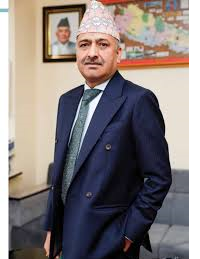
What is the current status of energy in Nepal and how crucial is it to have a diverse energy mix?
In Nepal, there is a notable disparity in power generation, with capacity peaking at 3600 MW during the rainy season but dropping to 1200 MW in winter. Given this situation, prioritizing a diverse energy mix is imperative. While run-of-the-river projects have been the traditional focus, there is now a shift towards storage-based projects, including solar, wind, and hydropower. Building storage capabilities is vital for ensuring energy security, and efforts are underway to develop tariff models for various storage options such as hydro storage and upcoming battery storage for solar energy. Additionally, pump storage projects are being explored. It is essential to diversify energy sources to reduce risks associated with dependence on a single power source.
What are the criteria for fixing electricity tariffs?
When determining the electricity tariff to be paid by consumers, the Commission considers various factors such as the operational costs of the electricity system, depreciation rates, repayment of principal and interest, maintenance costs, construction and operation of electricity structures, return on investment, power purchase agreements, changes in the consumer price index, revenue rates, and any changes therein.
How is the power purchase/sales rate determined?
The power purchase rate is established through mutual agreement between the generation licensee and the electricity-consuming industry or institution, with the consent of the ERC. This rate should be consistent with rates agreed upon with other industries or institutions of similar types.
Do you have the necessary tools for this process?
The Commission has developed and implemented standards for determining power purchase/sales rates between distribution licensees, generation licensees, trade licensees, and government-established corporate bodies. Two methods are used to determine power purchase tariffs: capacity charges, which include debt costs, and energy charges, which include equity, return, tax, royalty, operating and maintenance costs.
What is the role of the Commission?
The Commission plays a significant role, although its capacity is currently limited. As a new institution, we require a skilled team and readiness for the ecosystem. Support from development partners is needed to enhance our technical capabilities and strengthen the regulatory ecosystem. We are also working on implementing an e-hearing system. Public hearings are conducted before making decisions on matters such as electricity tariff fixation, power purchase/sales rate determination, transmission charges fixation, and power trade.

Keshab Poudel
Poudel is the editor of New Spotlight Magazine.
- FOURTH PROFESSOR Y.N. KHANAL LECTURE: Nepal-China Relations
- Jun 23, 2025
- Colonel JP CROSS: Centenary Birthday
- Jun 23, 2025
- REEEP-GREEN: Empowering Communities with MEP
- Jun 16, 2025
- BEEN: Retrofitted For Green
- May 28, 2025
- GGGI has been promoting green growth in Nepal for a decade: Dr. Malle Fofana
- May 21, 2025



